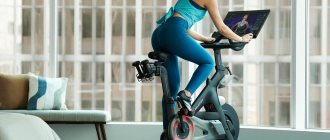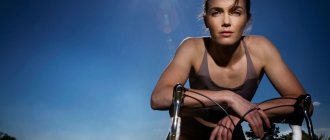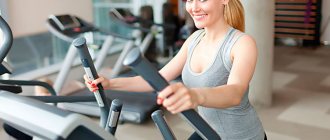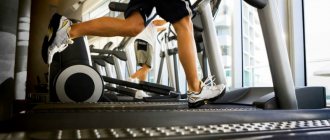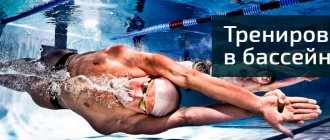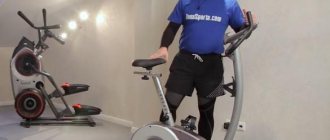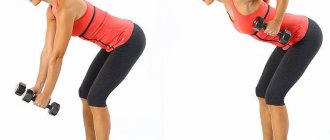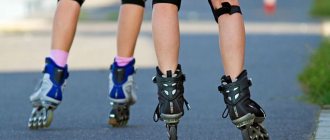Exercising on an exercise bike will significantly speed up the process of losing weight; the main thing is to choose the right training program and systematically increase the load so that the fat burning process does not stop. A positive effect can only be obtained by observing regular training.
3 reasons to lose weight on an exercise bike
Is it possible to tone up your stomach on an exercise bike if only your leg muscles work while riding? The answer is “Yes!”, which is due to the following parameters:
- Intensity of training - the process of exercising on an exercise bike stimulates the active work of the heart, which saturates the body with oxygen at a faster pace. The rest of the energy is spent by breaking down fats. This is why not only your legs lose weight, but your whole body evenly.
- Strain on the heart - regular exercise accelerates the blood and speeds up the metabolic process, which means that most of the extra calories and fats do not have time to be fully absorbed, which leads to weight loss.
- Strengthening and elasticity of the skin - cycling pumps up parts of the body, so its contours improve and cellulite disappears.
In half an hour of active training you can get rid of 500 calories, and additional adherence to a diet or proper nutrition will help you achieve results faster.
So, during training on an exercise bike, the load is not only on the legs, but also on the entire body as a whole, while it is a powerful pacemaker, which in turn accelerates the process of losing weight by burning fat.
Useful video
Also watch interesting videos on the topic:
In order to get comfortable with cycling training, it is important to use tips and recommendations on exercise technology and a balanced diet. In this case, the weight will steadily decrease without overexertion and loss of strength. This will serve as excellent motivation and will help you make such exercises a mandatory part of your daily routine.
Having reduced weight to the desired level, it is important to maintain the achieved results and ride an exercise bike for preventive purposes.
Exercise bike training programs
There are several types of special programs for training on an exercise bike for the purpose of losing weight, which you can adapt to yourself, based on your individual parameters.
Program for beginners
It is aimed at preparing beginner athletes to make the body more comfortable mastering more complex programs. Its essence is to gradually increase the load and duration of time - ranging from 5 to 35 minutes a day. Classes are held 3-4 times a week and last about 2 months.
An example of a 25-minute workout that is perfect for beginners:
- 3 minutes of slow pedaling and acceleration to 20 km/h
- 5 minutes - driving at a speed of 25 km/h
- 3 minutes - driving at a speed of 20 km/h at a load of 15%
- 3 minutes - driving at a speed of 25 km/h without load
- 3 minutes - driving at a speed of 20 km/h at 20% load
- 5 minutes - driving at a speed of 25 km/h
- 2 minutes - driving at a speed of 25 km/h
- 60 minutes – final ride at 15 km/h
Interval program
Contains several mini-programs at once, alternating with each other. Interval training example:
- Easy riding with a simple load - 3 minutes.
- Standard ride with normal load – 5 minutes.
- Increased loads - 3 minutes.
Next, we repeat steps 1-2-3 cyclically, ending the workout with easy riding. Having a high level of training, you can use the following training scheme: 1-2-3-2-3-2-3-3-2-3-2-3-2-1, where the numbers presented correspond to the type of training indicated above. The average duration of classes using interval training is 30-70 minutes.
The interval training program on an exercise bike is considered the most effective in terms of burning calories.
Interim program
It is aimed at consolidating the initial training and makes it possible to gradually increase the load. Training is carried out 3-5 times a week and lasts exactly 45 minutes. This type of program is preferred by most athletes, because At this stage, you can maintain your weight loss results and avoid gaining excess weight in the future.
It is at this stage that you can first notice the effect of losing weight, but do not expect instant results, since losing weight on an exercise bike is a long and gradual process.
Program for trained athletes
Ideal for those who have mastered the program for beginners and want to quickly get their figure into shape. This program has an intensive load lasting from 1 hour. The regularity of training is 5-7 times a week. This regime is aimed at actively burning fat. But you need to use this program only after mastering the initial or intermediate basics of training.
Number of calories burned
The main goal of training is usually weight loss. Therefore, it is necessary to know energy costs. They depend on a number of factors:
- pulse;
- initial weight;
- physical training.
The more a person weighs, the more calories they lose. Average energy consumption:
| Speed (km/h) | Consumption (kcal per hour) | |||
| 50 kg | 55 kg | 60 kg | 65 kg | |
| 15-16 | 274 | 301 | 342 | 353 |
| 19-20 | 371 | 420 | 451 | 476 |
| 22-25 | 485 | 515 | 565 | 627 |
| 30 | 590 | 635 | 680 | 730 |
| 35+ | 775 | 845 | 900 | 975 |
How to create an individual training program?
Training on an exercise bike should start with small load programs and gradually increase:
- The first training time is 10-15 minutes a day.
- After 1-2 weeks of training, the time of each subsequent workout can be increased by 5 minutes.
- After 1.5-2 months, classes should be 60-70 minutes.
The main thing is not to overdo it at the beginning of training and not to start training after getting used to long-term loads.
To get the first weight loss results, 4-5 weeks of active cycling should take place. You shouldn’t exhaust yourself with daily exercise on an exercise bike - you can get by with 3-4 sessions a week, but it’s worth considering that during training, your heart rate (HR) should be optimal. If it is more or less, there will be no weight loss.
The effective heart rate is an individual value and is calculated as follows:
- The maximum frequency is calculated using the formula: 220 - Age. For example, if you are 35 years old, then the maximum frequency will be 220 - 35 = 185.
- Effective heart rate is 65-75% of maximum. For example, if you take 70%, then it will be 130 (185 * 70 / 100%).
At different stages of training, the effective heart rate is different indicators:
- 55-65% - for beginners and during warm-up
- 65-75% - to start the weight loss procedure
- 70-80% - for training endurance and pumping muscles
After you have completed the training course for beginners, perform the cycling program for at least 30 minutes (regardless of the degree of difficulty), otherwise the process of losing weight in the body will not have time to start.
Basic rules of classes
The greatest benefits can be achieved only if you exercise correctly and regularly.
The effectiveness of an exercise bike for weight loss depends on the following parameters:
- following the technique, correct body position;
- tracking indicators;
- proper equipment;
- optimal loads.
Duration of training
Despite the fact that there are general standards, ready-made programs are advisory in nature. It is necessary to rely on individual indicators. If the simulator has a “weight loss” program, it will help you choose the right weight loss regimen on an individual basis.
This option is present on all the most modern electromagnetic simulators. But with proper and regular use, even the simplest one will help you lose weight.
A lesson can last from 40 minutes to an hour, it all depends on preparation, age, and excess weight.
Frequency of classes
When determining the regularity of classes, several factors are also taken into account. It is believed that the optimal amount is 5 times a week.
Some trainers recommend training every other day. The regime is suitable for getting rid of unnecessary pounds, restoring strength and lifting your mood.
Many instructors do not advise exercising more often, since the body needs rest for further training.
You cannot exercise intensively during pregnancy; training can only take place with the knowledge of a doctor.
Correct fit
Correct fit depends on the adjustment of the simulator to anthropometric parameters. Several nuances need to be taken into account:
- Distance to pedals . It doesn’t matter whether the exercise machine is vertical or horizontal, the principle is the same, the pedal at the lowest point should correspond to the length of the straight leg. If it remains bent constantly, the load increases greatly, which is dangerous for the knees.
- Exercise bike handlebar . This parameter is not always adjustable, but if the simulator has such an option, then most often the adjustment is carried out exclusively in height, without the ability to change the inclination. The most expensive exercise machines allow you to adjust the incline. In this case, it is necessary to set it in such a way that the arms remain bent at the elbows. It's bad if they are too bent or straight.
Direct landing:
- Your knees should move parallel to the machine and not be splayed out. This technique creates increased stress on the joints.
- It is necessary to sit with a motionless body, without waddling from side to side.
- The back should be straight. You should not set the resistance of the pedals too high, if you have to exert a lot of effort to rotate - this is not normal, the training does not bring benefits, and there is a danger to the joints.
- You should use comfortable shoes, sneakers with not too thick soles.
Cloth
There are also several simple requirements for clothing: it is necessary that movements are not constrained and that the fit is lightweight. Best solution: cycling shorts and a tank top. It is optimal to use special gloves for better contact with the steering wheel.
Technique
Technology is an important component of the entire process. The main mistake is incorrect position of the back, arching in the lower back. It is important that she is relaxed. You need to make sure that the weight is not transferred to your hands.
The position of the feet is parallel to the floor. Knees point inward and forward. Be sure to adjust the seat height. It is necessary to keep an activity log that will help you record detailed information, show distance traveled, heart rate, and so on.
This way you can achieve maximum training productivity and monitor the number of calories consumed and burned. This will help visualize the results in a journal for further evaluation.
Basic rules:
- Breathe evenly through your nose throughout your workout.
- Warm up. An obligatory part of the training. Includes exercises to warm up joints and muscles. Sometimes it is performed on an exercise bike at a measured pace.
- Hitch. Post-workout exercises are used to bring your heart rate back to normal.
Contraindications for exercise are malaise, deterioration of health, weakness.
The training program and duration should be optimal, taking into account the preparation and purpose of the training.
Preparatory stage
The guideline for choosing the time of training is the body’s biorhythms. Morning classes are good for those who like to get up early. It is better for night owls to practice in the afternoon or evening. The interval between training and sleep should be at least 2 hours in both directions.
Eating is allowed one and a half hours before classes, drinking drinks is allowed an hour before class. To eliminate the feeling of thirst during exercise, you can rinse your mouth or take small sips of water.
The warm-up program contains exercises that focus on the muscle groups involved in the workout. These are bends and squats or exercises for the back and shoulders. Since almost the entire load falls on the knees, you should warm up the joints and massage them.
Hitch
The load that completes the 30-40 minute main stage lasts about 10 minutes. The cool-down includes stretching exercises.
The complex includes:
- Raising your arms up to the sides.
- Alternately raise your shoulders, you need to try to reach your earlobes with them.
- Deep bend, tends to touch the floor.
- The legs in the starting position are shoulder-width apart, several lunges - putting one leg forward and transferring the body weight to it, then swaying slightly.
- Hold the wall with your right hand, grab your left heel and pull up to your buttock.
Each of these exercises is repeated for 30 seconds.
How to prepare for training and warm up?
It is not recommended to eat 2.5 hours before training, and immediately before sitting on the exercise machine, you need to put on comfortable sportswear. It is better to choose tight-fitting and breathable sportswear. A tank top and tight tights are ideal for working out, but if the room is hot, you can wear shorts. Shoes should be selected with thick soles, and they should not slip off the pedals of the simulator. Sneakers or sneakers are best.
Before training, you need to do a special warm-up:
- Stretch your shoulders: lift them towards your ears. Repeat 8-10 times.
- Stretch by raising your arms up. Repeat 10 times.
- Bend your legs one at a time, reaching your heel to your buttocks. Repeat 10 times on each leg.
- Bend back and forth 5-6 times.
- Perform squats - 10 times.
It is not advisable to drink water during warm-up and training, but you can simply rinse your mouth.
How long to pedal
The standard time for a full workout is considered to be 40-60 minutes. But much depends on the individual characteristics of the body and the physical preparation of the athlete, his goals and the format of his training.
For an untrained user, this time is too long; you should start with 15-20 minutes. There is no need to overstrain the body, nothing good will come of it, it is better to start with a short workout, gradually increasing it. The load level should also be gradually increased.
The nature of the training also matters; the time spent on intense interval training is less than training carried out at a uniform pace.
In many ways, the training time depends on the athlete’s goals; for those who want to lose weight, the session should not last less than 40 minutes, and for those who want to add additional activity to their lifestyle, 20 is enough.
If you work out on a simulator with the ability to choose among the installed programs, then choose the one that suits you. But the time allotted for it is of a recommendatory nature; if you feel very tired and exhausted, then reduce the training based on your capabilities.
A positive effect from training can be achieved even on the simplest simulator without any special programs, the main thing is their regularity.
How to properly exercise on an exercise bike?
When training on an exercise bike, be sure to adhere to the basics of proper technique:
- The back is partially relaxed and should not bend.
- Hands should not be stressed.
- The head is directed forward, as if you are looking at the road while driving.
- Your feet on the pedals should be parallel to the floor.
- Watch your breathing - it should be even, through your nose. It is permissible to inhale through the nose and exhale through the mouth.
- Under no circumstances should you abruptly interrupt the training process. To complete the process, smoothly switch to the minimum load, and only then complete the process.
Before starting classes, set up the exercise bike, making sure to adjust the seat to your physical parameters.
The basics of riding an exercise bike are covered in the following video:
Exercises on the simulator must be carried out in a good, cheerful state. If you feel weak and unwell, there will be no benefit from the exercise, and you will only get harm.
Sportswear
It is better to choose comfortable clothes that do not restrict movement.
Avoid wearing sweatpants that are too long or wide. Shorts or breeches are much better. For girls, you can choose weight loss breeches with a sauna effect. Here are some options:
Choose clothes made from natural materials, preferably cotton, or special clothing for fitness. These materials wick away sweat well and allow air to pass through.
For training, sneakers with a grooved sole are suitable to prevent your foot from slipping on the pedal, such as these.
For girls with long hair, it is better to wear a sports headband or tie your hair in a bun so that it does not get into your eyes and does not interfere with your workout.
Training Performance Monitoring
To select optimal loads and track weight loss results, you need to monitor your training performance on an exercise bike. Always measure your heart rate, monitor the distance traveled, the time and state of exercise, and the number of calories lost (if such a function is available on the exercise bike’s sensor). It is advisable to record all these indicators in a special diary in order to clearly see your results, compare them and select more effective types of training.
Benefits of a bicycle
A bicycle is an excellent and economical means of transportation. In some countries with high population densities, this is generally the main mode of transport. For us, it’s a way to spend time actively and with pleasure.
The importance of two wheels for our health
The bicycle is propelled by the power of the legs, and the legs are the largest muscle group in our body. Intensive pedaling creates a number of positive effects:
- Losing weight. When you ride uphill or set the machine to high resistance, you burn a huge amount of calories. A good cycling trainer has several modes of operation, including allowing you to vary the intensity of the load and do intervals.
- Actually, muscle training. Notice how strong the leg muscles of famous cyclists are. Although not as noticeable as when working with iron, the muscles still sway. They become stronger, denser and more prominent.
- Development of endurance.
- Strengthening blood circulation throughout the body and improving the functioning of the cardiovascular system.
The maximum benefit for our health lies in the last point.
During intense cardio, the body urgently needs oxygen. It makes the heart beat faster. Blood spreads throughout the body faster, and cells are better supplied with oxygen. As your fitness increases, each heartbeat becomes more efficient and your maximum cardiac output increases.
That is, with regular exercise, your pulse will no longer skyrocket, your heart will beat slower (which is safer for it), but at the same time pump more blood with each beat.
And finally, the most important thing is that blood flows to the brain. And this is stroke prevention.
It is worth remembering that if you are an unprepared person, you do not need to bring your heart rate to the maximum values. How to determine the maximum limit? During intense riding, you should be able to say a word or two without losing your breath. But holding a conversation while doing cardio must be difficult.
Are there any restrictions for cycling?
If you are generally healthy and full of strength, you can pedal for as long as you like. The main thing is to monitor your well-being.
If you sit or adjust the seat and steering wheel incorrectly, you may experience pain in the lower back and wrists. This problem can be solved by adjusting the iron horse to your parameters.
If there are contraindications to physical activity or work, you should limit the duration and intensity of training. So, for people with diseases of the cardiovascular system, leisurely driving will only bring benefits. The heart rate will be slightly accelerated, but will not reach high values.
In a word, cycling training is good medicine and great benefits for the body.
A cyclist passes an intersection:
Correct 8. Traffic regulation
8.3. Traffic controller signals take precedence over traffic light signals and road sign requirements and are mandatory. Traffic lights, other than flashing yellow ones, take precedence over priority road signs. Drivers and pedestrians must comply with the additional requirements of the traffic controller, even if they contradict traffic lights, road signs and markings.
16. Driving through intersections
16.6. When turning left or turning around when the main traffic light is green, the driver of a non-rail vehicle is obliged to give way to a tram in the same direction, as well as to vehicles moving straight in the opposite direction or turning right. Tram drivers should follow this rule among themselves.
Wrong 8. Traffic control
8.3. Traffic controller signals take precedence over traffic light signals and road sign requirements and are mandatory. Traffic lights, other than flashing yellow ones, take precedence over priority road signs. Drivers and pedestrians must comply with the additional requirements of the traffic controller, even if they contradict traffic lights, road signs and markings.
16. Driving through intersections
16.6. When turning left or turning around when the main traffic light is green, the driver of a non-rail vehicle is obliged to give way to a tram in the same direction, as well as to vehicles moving straight in the opposite direction or turning right. Tram drivers should follow this rule among themselves.
12.
What distance should be between groups of cyclists moving in a column?
Correct 6. Requirements for cyclists
6.3. Cyclists traveling in groups must ride one after another so as not to interfere with other road users. A column of cyclists moving along the roadway must be divided into groups (up to 10 cyclists in a group) with a movement distance between groups of 80-100 m.
Wrong 6. Requirements for cyclists
6.3. Cyclists traveling in groups must ride one after another so as not to interfere with other road users. A column of cyclists moving along the roadway must be divided into groups (up to 10 cyclists in a group) with a movement distance between groups of 80-100 m.
10.
In what order will vehicles pass through the intersection?
Correct 16. Driving through intersections
16.11. At an intersection of unequal roads, the driver of a vehicle moving on a secondary road must give way to vehicles approaching this intersection of carriageways on the main road, regardless of the direction of their further movement.
16.12. At the intersection of equivalent roads, the driver of a non-rail vehicle is obliged to give way to vehicles approaching from the right. Tram drivers should follow this rule among themselves. At any unregulated intersection, a tram, regardless of the direction of its further movement, has an advantage over non-rail vehicles approaching it along an equivalent road.
16.14. If the main road at an intersection changes direction, drivers of vehicles moving along it must follow the rules for driving through intersections of equivalent roads. This rule should be followed among themselves and by drivers driving on secondary roads.
Wrong 16. Driving through intersections
16.11. At an intersection of unequal roads, the driver of a vehicle moving on a secondary road must give way to vehicles approaching this intersection of carriageways on the main road, regardless of the direction of their further movement.
16.12. At the intersection of equivalent roads, the driver of a non-rail vehicle is obliged to give way to vehicles approaching from the right. Tram drivers should follow this rule among themselves. At any unregulated intersection, a tram, regardless of the direction of its further movement, has an advantage over non-rail vehicles approaching it along an equivalent road.
16.14. If the main road at an intersection changes direction, drivers of vehicles moving along it must follow the rules for driving through intersections of equivalent roads. This rule should be followed among themselves and by drivers driving on secondary roads.
7.
Flashing red signals of this traffic light:
Correct 8. Traffic regulation
8.7.6. To regulate traffic at railway crossings, traffic lights with two red signals or one white-lunar and two red ones are used, having the following meanings:
a) flashing red signals prohibit the movement of vehicles through the crossing;
b) a flashing white-lunar signal indicates that the alarm system is working and does not prohibit vehicle movement.
At railway crossings, simultaneously with the prohibitory traffic light signal, an audible signal may be turned on, additionally informing road users that movement through the crossing is prohibited.
Wrong 8. Traffic control
8.7.6. To regulate traffic at railway crossings, traffic lights with two red signals or one white-lunar and two red ones are used, having the following meanings:
a) flashing red signals prohibit the movement of vehicles through the crossing;
b) a flashing white-lunar signal indicates that the alarm system is working and does not prohibit vehicle movement.
At railway crossings, simultaneously with the prohibitory traffic light signal, an audible signal may be turned on, additionally informing road users that movement through the crossing is prohibited.
13.
What muscles work while riding?
What muscles work when riding a bicycle? These are mainly knee and ankle extensors - quadriceps and calves. The flexors only return the pedal to its original state, and the main force comes from turning the pedals by pushing them downwards. Sometimes you put almost your entire body weight on them. This is a good load that allows you to strengthen these muscle groups.
The legs of a cyclist are clearly stronger than those of a person who simply walks. Cycle training is not only cardio, but also a good workout for muscles.
If you don’t know how to ride and don’t just want to lose weight, cycle aerobics and a good fitness room will help you!
The driver of which vehicle will cross the intersection second?
Correct 16. Driving through intersections
16.11. At an intersection of unequal roads, the driver of a vehicle moving on a secondary road must give way to vehicles approaching this intersection of carriageways on the main road, regardless of the direction of their further movement.
16.14. If the main road at an intersection changes direction, drivers of vehicles moving along it must follow the rules for driving through intersections of equivalent roads.
This rule should be followed among themselves and by drivers driving on secondary roads.
Wrong 16. Driving through intersections
16.11. At an intersection of unequal roads, the driver of a vehicle moving on a secondary road must give way to vehicles approaching this intersection of carriageways on the main road, regardless of the direction of their further movement.
16.14. If the main road at an intersection changes direction, drivers of vehicles moving along it must follow the rules for driving through intersections of equivalent roads.
This rule should be followed among themselves and by drivers driving on secondary roads.
14.
5 More Tips to Increase Efficiency
There are tips that you should listen to:
- Cycling training will be effective only if you follow the principles of a rational and balanced diet.
- Give up desserts and everything you are supposed to buy for tea.
- Your daily menu must include proteins (boiled or baked fish or chicken, vegetable dishes, fresh herbs, lactic acid products with a small percentage of fat).
- It is advisable to add gymnastic exercises, Pilates, and yoga to cycling training. This will allow for more harmonious development of all major muscle groups.
- The speed of weight loss is different for everyone, so don’t rely on others, just follow the recommendations for proper nutrition and regimen, and adhere to the energy consumption table.
Attention! Exercise regularly, for example every other day.
The body will recover well and rest fully. Also check out the video on the topic:
Remember that all training programs are advisory in nature. When trying out a workout, adapt it to yourself, your schedule and capabilities. Take into account your general level of physical fitness, health status, and the presence of extra pounds. If you are overweight, be gentle with yourself and do not set high intensity levels.
Include different types of physical activity in your cycling training - swimming, brisk walking, oriental exercises (yoga). Then the weight will go away gradually without threatening your health, and the lost kilograms will not return.
Who should give way?
Correct 6. Requirements for cyclists
6.5. If a bicycle lane crosses a road outside an intersection, cyclists must give way to other vehicles traveling on the road.
Wrong 6. Requirements for cyclists
6.5. If a bicycle lane crosses a road outside an intersection, cyclists must give way to other vehicles traveling on the road.
4.
Cycling in a group or on your own at home?
Whether you engage in cycling in a group or at home on your own depends entirely on your preferences. For example, the energy of a group cycling class can motivate you on days when you don't feel like doing it alone.
“Riding in a dark room with loud music and the personal energy of other riders creates an unforgettable experience,” says Lorenz.
At the gym or studio, you're more likely to work out harder. But home workouts allow you to structure your workout so that you can focus on what you really need. You can even watch your favorite TV show, listen to a podcast, or just relax during your workout. Create your own workouts depending on the time you have. Start by choosing your favorite songs, and then either pedal faster or increase the resistance in rounds of interval training.
Or you can recreate your workout outdoors. Climb the hill with a slow and steady first song, increasing the resistance on each chorus for the second song, as if you were climbing a steep hill. Then move with moderate resistance to a plateau with the third song, another climb with the fourth song, then lower resistance, sprint down the hill with the last song before recharging.
Which cyclist doesn't break the rules?
Correct 6. Requirements for cyclists
6.6. A cyclist is prohibited from:
b) move on highways and roads for cars, as well as on the roadway if there is a bicycle path nearby;
Wrong 6. Requirements for cyclists
6.6. A cyclist is prohibited from:
b) move on highways and roads for cars, as well as on the roadway if there is a bicycle path nearby;
3.
Which cyclists violate the Rules when transporting passengers?
Correct 6. Requirements for cyclists
6.6. A cyclist is prohibited from:
e) carry passengers on a bicycle (except for children under 7 years old, transported on an additional seat equipped with securely fastened footrests);
Wrong 6. Requirements for cyclists
6.6. A cyclist is prohibited from:
e) carry passengers on a bicycle (except for children under 7 years old, transported on an additional seat equipped with securely fastened footrests);
6.
Vehicles will pass through the intersection in the following order
Correct 16. Driving through intersections
16.11. At an intersection of unequal roads, the driver of a vehicle moving on a secondary road must give way to vehicles approaching this intersection of carriageways on the main road, regardless of the direction of their further movement.
16.13. Before turning left and making a U-turn, the driver of a non-rail vehicle must give way to a tram in the same direction, as well as to vehicles moving on an equivalent road in the opposite direction straight or to the right.
Wrong 16. Driving through intersections
16.11. At an intersection of unequal roads, the driver of a vehicle moving on a secondary road must give way to vehicles approaching this intersection of carriageways on the main road, regardless of the direction of their further movement.
16.13. Before turning left and making a U-turn, the driver of a non-rail vehicle must give way to a tram in the same direction, as well as to vehicles moving on an equivalent road in the opposite direction straight or to the right.
11.
Contraindications
Even if you are absolutely healthy, consulting a doctor before cycling training will not be superfluous. During the first lessons, carefully monitor your feelings. If nausea, shortness of breath, heart pain, or dizziness occur, exercise should be stopped.
The following are considered contraindications to exercise on an exercise bike:
- Hypertension stages 2 and 3;
- Cardiovascular failure;
- Angina pectoris and ischemic disease;
- Asthma;
- Thrombophlebitis;
- Tachycardia;
- Diabetes mellitus in the acute phase;
- Oncological diseases.
You should not start training if you have a cold, have an infectious disease, or feel weakness or pain in your joints and spine. If you have untreated injuries, sprains, or bruises, use protective equipment - compression bandages, special tapes for fixation.
Can a cyclist turn left?
Correct 11. Location of vehicles on the road
11.14. Movement on the roadway on bicycles, mopeds, horse-drawn carriages (sleighs) and horseback riders is permitted only in one row in the rightmost lane as far to the right as possible, except for cases when a detour is in progress. Left turns and U-turns are permitted on roads with one lane in each direction and no tram tracks in the middle. Driving on the side of the road is permitted if this does not create obstacles for pedestrians.
Wrong 11. Location of vehicles on the road
11.14. Movement on the roadway on bicycles, mopeds, horse-drawn carriages (sleighs) and horseback riders is permitted only in one row in the rightmost lane as far to the right as possible, except for cases when a detour is in progress. Left turns and U-turns are permitted on roads with one lane in each direction and no tram tracks in the middle. Driving on the side of the road is permitted if this does not create obstacles for pedestrians.
( 2 ratings, average: 2.50 out of 5)
